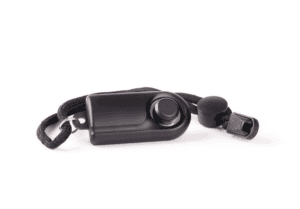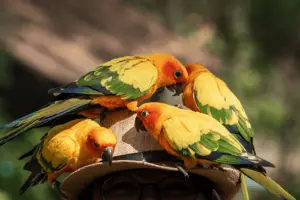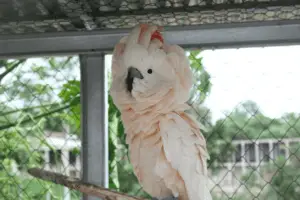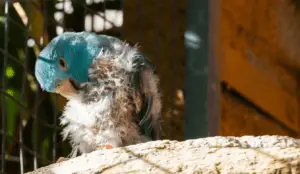It is often best to purchase budgies in pairs for new budgie owners. After all, they can get lonely; plus, with our busy schedules, we may find less time to spend with them. Therefore, most budgie owners always adopt a pair.
Potentially, the pair of budgies you adopt may be female or male. If that’s the case, then there is a high likelihood of them reproducing at some point. That said, they will require the right environment, which includes many factors. So do budgies need a nesting box?
Key Takeaways
- The budgie can breed without a breeding box, but having one is always good.
- You must get the right environment, housing, food, and exercise. The budgie rarely builds a nest in the wild, so it lays eggs in the tree cavities.
- You must add soft materials to the enclosure’s floor to prevent splayed legs.
- Since it will lay eggs, you must feed it cuttlebones and calcium supplements.
- Without proper preparation, you might end up with unfertilized eggs resulting in them not hatching.
Budgies are popular pets best kept in pairs, meaning you can raise them together. In this article, we’ll answer the question; do budgies need a nesting box? We’ll also show you what budgies use for nesting. For answers to these questions and more, please read on.
Do Budgies Need A Nesting Box?
Even though they can breed with or without a nesting box, having one is always a good idea. These birds breed readily in the wild, even without a nest. Provided the conditions are favorable, the bonded budgies will breed. Therefore, they’ll produce in the tree cavities; they don’t require building a nest.
Providing them with a nesting box that mimics this environment can significantly help. The locals in Florida provided budgies with a nesting box in their backyard to help maintain their population. Since they inhabit open woodlands, they’re known for building a nest in rock crevices or tree hollows.
Nesting boxes are more comfortable and guarantee that most eggs hatch. Therefore, if you’re keeping these birds, you should give them a nesting box.
If they breed without a nesting box, they will likely get infertile eggs, lost chicks, low hatching rates, and poor incubation. But if you prefer to go without a nesting box, you should create several places where they can feel safe to mate and even lay their eggs. You can try PVC pipes or stacked boxes.
Remember, they can quickly breed without a breeding box, but you must ensure the cage is draft free and well-ventilated. Don’t forget to place some soft materials at the bottom of the cage.
Darkness is necessary to guarantee that the female’s hormone for ovum maturation is well stimulated. But providing them with some nesting materials isn’t a good idea since they don’t build their nests.
What Do Budgies Use For Nesting?
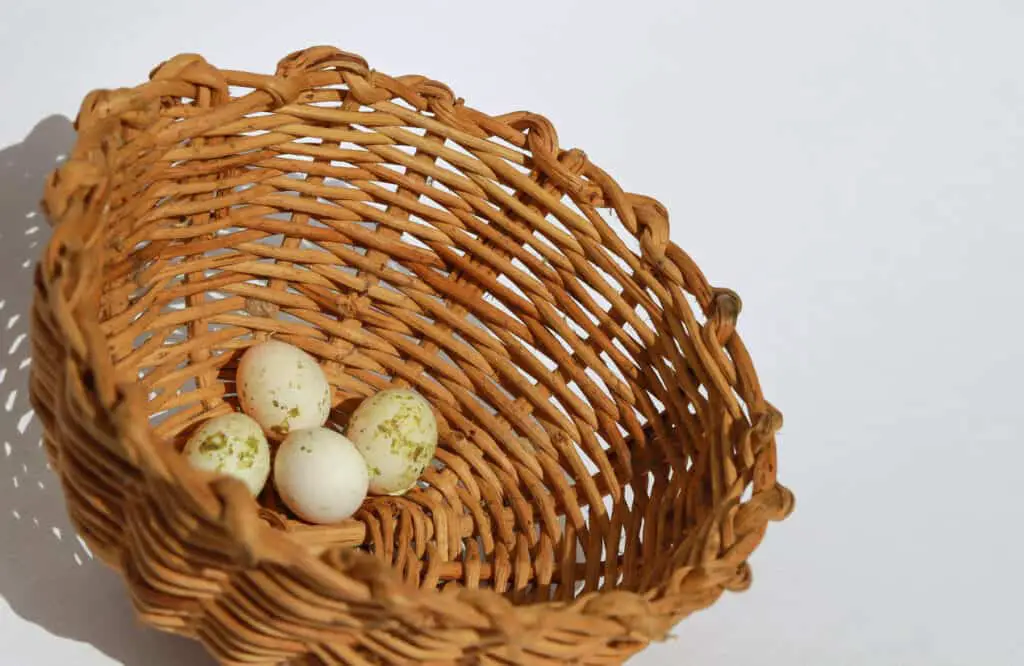
Every bird, including budgies, requires a soothing and comfortable environment that lets them rest, especially when breeding.
The best way to protect your pet is by providing a nesting box. As mentioned, you don’t require many materials as they won’t build the nest anyway. But it should contain a tray for the females to lay their eggs.
With that said, we need to understand that budgies are minimalist nesters. Therefore, keeping the dry floor region lined with soft materials instead of trays is mandatory. You can use either shredded paper or untreated wood shavings.
In the wild, they love pine wood; therefore, you can get unscented pine shavings from the pet store. You can purchase it in small or large cubes.
The female bird will arrange the shavings to its liking; therefore, you should provide her with something to work with.
Paper beddings are great and can come in various colors, shapes, and textures. Plus, they’re very safe for our birds. Alternatively, you can also go for the newspapers but avoid glossy or colored newspapers.
You’ll also need concave inserts for the nesting boxes to prevent splayed legs. Splayed legs are common conditions when the chicks are left standing on a flat, hard surface for a long time. The splayed leg is common among the chicks.
You should also provide water and food after the eggs have hatched. The parent budgies will eat more seeds, especially when caring for the chicks. Therefore, you’ll need to give them more than usual.
Minerals, particularly calcium supplements and cuttlebone, should also be available to help with egg development. These minerals will help your bird recoup the lost nutrients during the egg-making process.
Last but not least, the design and size of the box should be at least 12 by 12 inches. But ensure it has a 1.5 inches wide hole at the doorway for the birds to enter.
At What Age Do Budgies Breed?
Budgies are known to live for over eight years, while parakeets can attain 14 years. Therefore, they have several breeding seasons in their lifetime. Your budgie should start to breed at about six months, but some individuals will begin at almost a year old.
Does the Budgie Mate For Life?
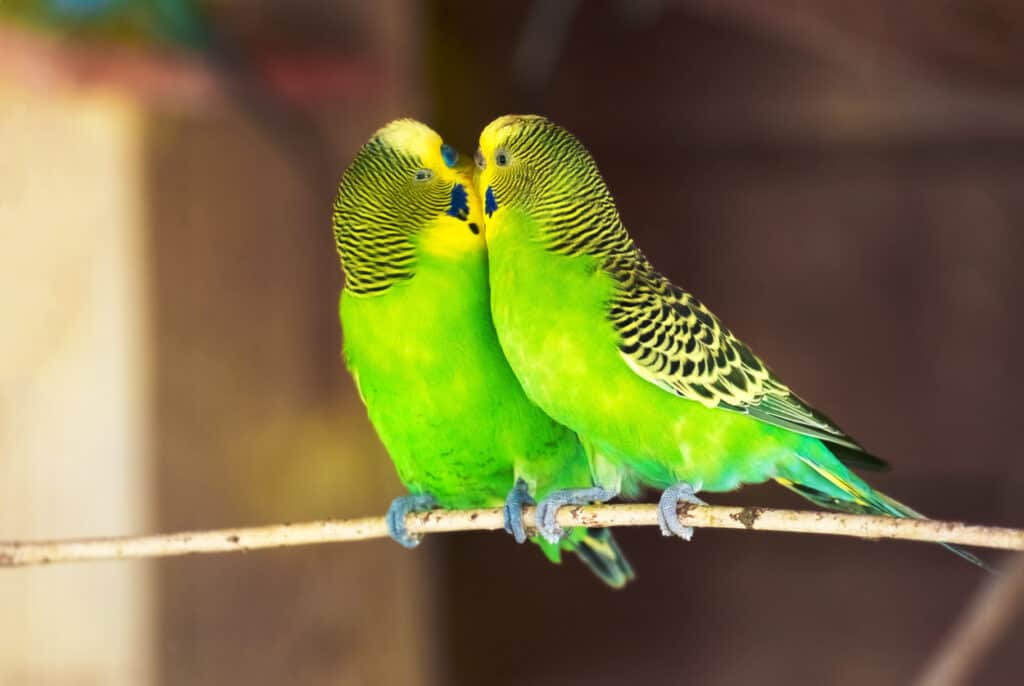
Like the lovebirds, the budgie mates for life. But in most cases, it is not always that straightforward. They’re monogamous creatures, meaning they can form a pair bond and live together for a lifetime. It doesn’t mean that each pair’s bond can be permanent.
Therefore, if a partner gets sick or dies, the remaining bird can get a new mate. So, you should be ready to introduce your pet to another mate even after it has matured.
How To Encourage The Budgies To Breed?
Before breeding budgies, your pet must be healthy and given the right breeding conditions. They also need a three-month breeding diet before introducing a nest box in their cage. But you have to encourage your pet to start breeding.
Remember, you should be ready to do everything, which means knowing more about their breeding seasons. And then prepare your pet for the breeding seasons. So here are a few tips to help encourage your pet to breed:
Bonding And Pairing
First and foremost, you must note that for any budgie to pair and even breed, they must be compatible and bonded. Unfortunately, not every budgie can connect with your budgie, and without proper preparation, you may adopt one from a group that won’t pair with your pet. You should be ready to take your time with the breeding process.
Therefore, the first sign that your budgies have bonded is if they start holding beaks or preen each other. These signs will help you determine if they will take time to mate sooner or later. If one of the birds is interested, then there is a high probability that your pair won’t be compatible.
For example, a male budgie may try to feed or even kiss the female, but if she’s not willing to sit with the male, then it won’t work. She may nip the male or even push him away.
But if the female is willing to breed, it will show interest by taking a mating pose. On the other hand, the male may not be ready to mount even after the female has taken a mating pose. So if, for one or two reasons, you suspect that the pair won’t bond, I recommend that you try pairing it with another female.
Nesting Box And Enclosure
Once the pair has bonded, they should be ready to breed, so you should separate it from the flock if you have more than two budgies. It would help if you prevented other males from interfering with the pair, placing a large enclosure, preferably about 24 by 18 by 18 inches.
If they already have a big enclosure, you’ll have to make several changes to it, including introducing a nesting box. Remember, the nesting box doesn’t have to be too elaborate. But most importantly, you must add the necessary items to help them get used to the cages.
Remember, where you place the nesting box will determine how fast the budgie breeds. If your bird doesn’t consider the nest box safe for its eggs, it is highly likely that the female will never be mentally ready.
Some small things that can affect your pets from breeding are being too low or not being private enough. It is best to consider covering three sides of the cage with your blanket to help the birds breed while remaining comfortable. You should also ensure that the nest box is high with its entrance not facing outward.
Breeding Conditions
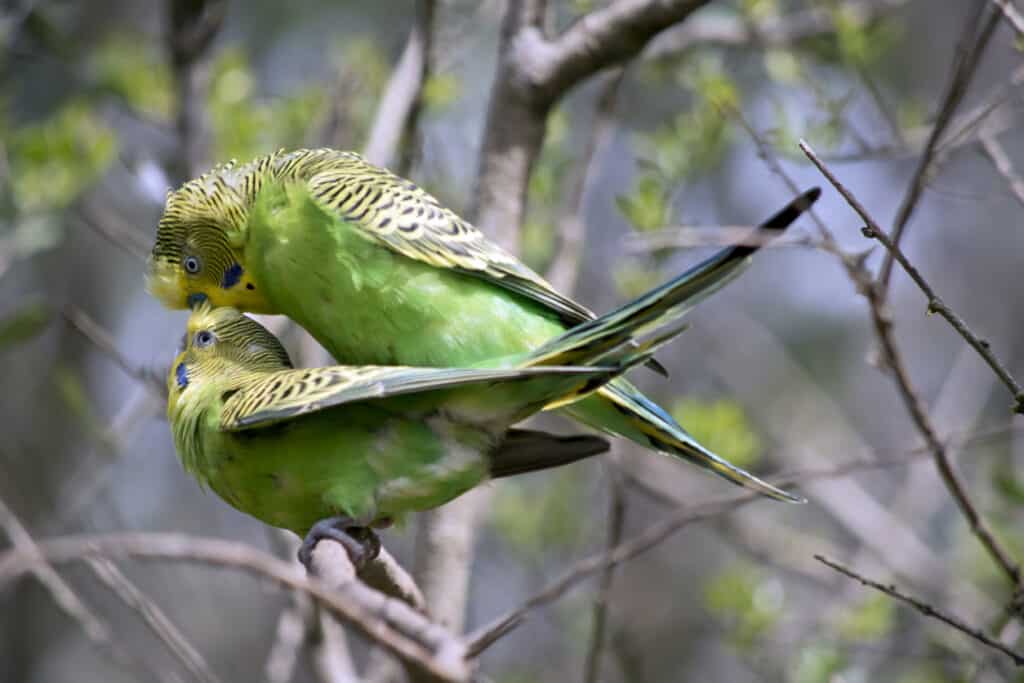
In the wild, according to Wikipedia, budgies are opportunistic breeders who only respond to the rainy season when abundant seeds are abundant. During the wet seasons, they have longer light hours to find the necessary supplies. Therefore, mimicking some settings can help your pet reproduce.
Provide your budgies with high-fat and protein foods, increasing calcium intake by adding liquid calcium, mineral blocks, and cuttlebone. Spraying the birds with some water can help mimic the rainy season while improving their time in artificial light can also go a long way to conditioning them. Increasing their time to over 10 hours of exposure to sunlight can help.
Generally, breeding conditions can considerably change their body as they prepare for reproduction. Therefore, there are some signs that you have to watch out for. When the birds start getting to this point, your birds are primed and ready to raise the chicks.
The most conditioning symptom most owners look out for is the changes in the cere. For instance, if cere (the skin above the beak) is not brownish, she is not conditioned for breeding.
Budgies’ Behavior Before Laying Their Eggs
After the mating time, the female budgie will position herself in its nesting box. they will start arranging some minimal furnishings. They can emerge to consume the cuttlefish and mineral block. Their partners may feed her with some regurgitated food, especially when they’re nest bound.
The female’s abdomen can become visibly swollen when the eggs develop, particularly the vent region. Another change will be their droppings increasing in size and color change.
Why Are The Budgie Eggs Not Hatching?
Generally, there are several reasons why eggs cannot hatch. Some of these reasons include the following:
- They can still lay eggs even when there is no male around.
- The male may be sterile.
- The female may lay unfertilized eggs.
- If the enclosure houses several birds, the overcrowding can leave your pet stressed and avoid sitting on the eggs.
- Single eggs can fail to hatch due to poor positioning.
Conclusion
Budgies are the world’s third most popular pets loved by bird lovers worldwide. They’re stunning creatures available in a wide range of color combinations. The probability of creating a unique breed has inspired most budgie lovers to try breeding. On the other hand, they’re social creatures, so they need company even in your absence.
Therefore, getting them in pairs is always a good idea; after eight months, you can try breeding them. Fortunately, these birds can mate with or without a nesting box, but having one is always a good idea. A nesting box can increase the likelihood of your parrot’s eggs hatching. Plus, it would help if you gave it the right mineral combinations to keep it healthy.
- The Budgerigar in Florida,https://sora.unm.edu/sites/default/files/journals/nab/v055n04/p00389-p00397.pdf/ Accessed March 22, 2023
- YouTube contributor, My budgies are breeding without breeding box,https://www.youtube.com/watch?v=GgLit0EiE9A/ Accessed March 22, 2023
- Wikipedia contributor, Spraddle leg,https://en.wikipedia.org/wiki/Spraddle_leg/ Accessed March 22, 2023
- Wikipedia contributor Budgerigar,https://en.wikipedia.org/wiki/Budgerigar#Breeding/ Accessed March 22, 2023
- Kelly Sims, Melopsittacus undulates, Budgerigar,https://animaldiversity.org/site/accounts/information/Melopsittacus_undulatus.html/ Accessed March 22, 2023



